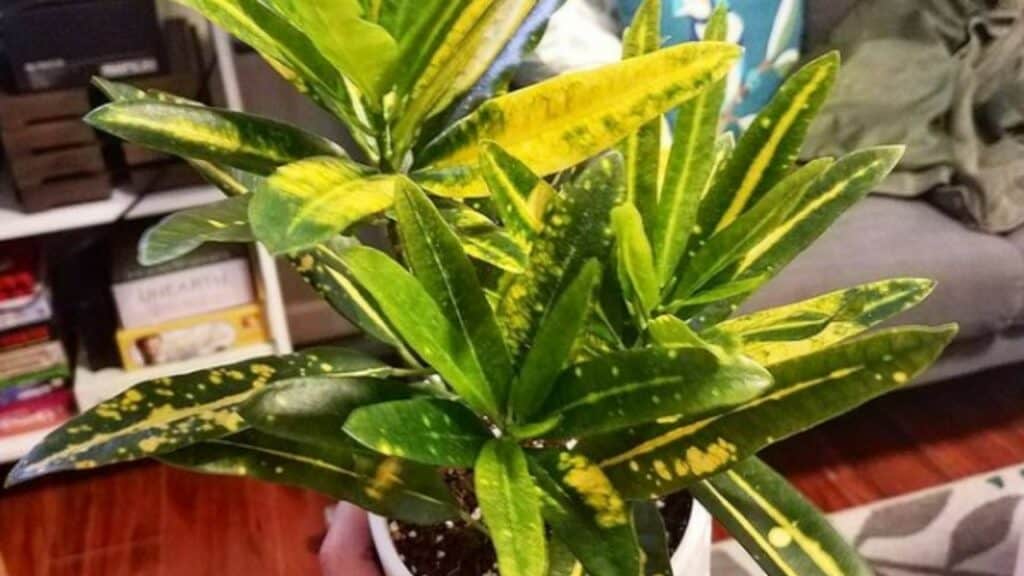Rescue your Banana Croton from root rot by learning the early warning signs and effective treatments.
Known for their vibrant, tropical-inspired foliage, banana croton plants can add a pop of color to any indoor space. However, these plants are susceptible to rot, which can quickly kill them. In this article, we’ll look at what causes rot in banana croton plants, and how to prevent and treat it.
What is Rot?
Rot is a fungal or bacterial disease that causes plant tissues to decay and die. The affected areas turn black brown, or mushy as the cells break down. Rot can strike the roots stems, leaves, or flowers of a banana croton plant. If left unchecked, it will spread through the whole plant, eventually killing it.
Root Rot
One of the most common types of rot in banana croton plants is root rot. As the name suggests, this targets the roots. It is caused by overwatering, which leaves the soil perpetually soggy. With no oxygen reaching the roots, they are unable to respire properly and start to die.
Signs of root rot include
- Wilting or drooping leaves
- Loss of leaves
- Slow growth
- Mushy, rotten roots
To prevent root rot, make sure the plant is in a pot with drainage holes and well-draining soil Only water when the top inch of soil is dry, and empty excess water from the saucer
Stem and Leaf Rot
Rot can also appear on the stems and leaves of a banana croton plant, caused by:
- Overwatering – Wet foliage leads to fungal and bacterial growth
- High humidity – Creates ideal conditions for pathogens
- Wounds – Damage to stems/leaves allows infection entry
You’ll notice black or brown, water-soaked spots on the leaves and stems that expand rapidly. Pruning off affected parts as soon as rot appears can stop it spreading. Improve airflow and cut back on watering to make conditions less hospitable for rot pathogens.
How to Prevent Rot
Luckily, there are several ways to prevent rot from taking hold in your banana croton plant:
-
Water properly – Only when the top inch of soil is dry. Pour off excess water.
-
Use well-draining soil – Mix in perlite, orchid bark, or sand to improve drainage.
-
Allow soil to dry out between waterings – Don’t keep it constantly wet.
-
Give it bright light – Low light promotes fungal growth.
-
Keep leaves dry – Avoid wetting foliage when watering.
-
Provide good ventilation – Stagnant air spreads spores.
-
Treat wounds – Disinfect shears between prunings. Seal cuts with paste.
-
Check for pests – Damaged leaves can lead to rot.
-
Maintain proper humidity – 40-60% is ideal.
How to Treat Rot
If you spot rot on your banana croton plant, take action right away:
-
Quarantine the plant to avoid spread.
-
Cut off all affected parts – leaves, stems, roots.
-
Apply fungicide to remaining healthy tissue.
-
Repot in sterile, well-draining soil.
-
Water sparingly until established.
-
Increase light and airflow.
-
Monitor closely for reemergence of rot.
-
Discard the plant if rot becomes severe.
With quick intervention, you can often stop rot and save afflicted plants. But prevention is more effective – following proper cultural practices can help keep your banana croton rot-free.
FAQs About Rot in Banana Croton Plants
What causes black spots on banana croton leaves?
Black leaf spots are usually caused by a fungal infection. The fungus thrives in wet conditions. Improve airflow and reduce watering to prevent its spread.
My banana croton stems are turning black – what should I do?
Black, mushy stems are a sign of serious stem rot. Cut off all affected parts back to healthy tissue and treat with a fungicide. Isolate the plant to avoid spread.
I overwatered my banana croton – will it get root rot?
It’s possible. Check that the roots are firm and white, not brown and mushy. If rot has set in, you’ll need to trim off all affected roots before repotting in fresh, sterile soil.
What is the black mushy stuff on my banana croton’s roots?
That black mush is likely root rot – a fungal infection. You’ll need to remove all of the infected root material and treat any remaining healthy roots with a fungicide before repotting.
Can I reverse rot once it starts in my banana croton plant?
If caught early, removing affected parts and treating with a fungicide can stop rot’s spread. But if rot is advanced, the plant likely can’t be saved and must be discarded to protect other plants.
By understanding what causes rot and how to prevent it, you can keep your beautiful banana croton plant thriving for years to come. With proper care, this eye-catching plant will brighten your indoor garden.

First Aid for Your Croton: Treating Root Rot
After diagnosing root rot, immediate action is required. Start by halting all watering to stop the rot from spreading. Your Crotons roots need a breather, so let the soil dry out. This isnt neglect; its tough love.
Grab those sterilized scissors and get to work. Trim away the brown, mushy roots with precision. Its like giving your plant a life-saving operation. Remember, only healthy, white roots should remain.
Cleanliness is next to godliness, especially in plant surgery. Sterilize your tools with alcohol or bleach solution to prevent further infection. Its the plant equivalent of washing your hands – non-negotiable.
Fresh Start with New Soil
Select a soil mix thats well-draining and airy. Your Crotons roots despise being waterlogged. Think of it as setting the stage for a root revival.
Time to repot. Be gentle, yet firm. Place your Croton in its new pot and fill with the fresh soil mix. Water sparingly, just enough to settle the soil around the roots. Overwatering now would be like jumping back into the deep end right after a near-drowning experience.

